
Home - Search - Browse - Alphabetic Index: 0- 1- 2- 3- 4- 5- 6- 7- 8- 9
A- B- C- D- E- F- G- H- I- J- K- L- M- N- O- P- Q- R- S- T- U- V- W- X- Y- Z
STS-51-L
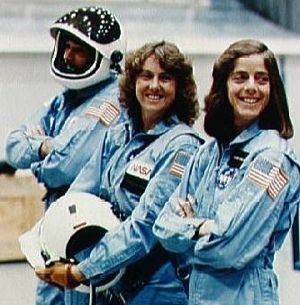 STS-51-L Payload specialists in training for STS 51-L in mock-up & integration lab Credit: NASA |
AKA: Challenger. Launched: 1986-01-28. Returned: 1986-01-28. Number crew: 7 . Duration: 0.0008 days.
Exploded 73 seconds after launch, all seven crewmembers were killed and the TDRSS satellite aboard was destroyed. The crew cabin remained intact after the shuttle Challenger disintegrated. Indications that emergency oxygen supplies were manually activated showed that some crew members may have remained alive until the cabin hit the ocean.
Prior to Challenger's launch, NASA was stretched to the limit. It had advertised the shuttle was providing cheap access to space, but this could only be achieved if the flight rate reached 20 per year, or one every two weeks. But the shuttle turned out to be a maintenance nightmare. Every one of the 28,000 tiles had to be checked before each flight, software for each mission had to be individually written, tested, debugged, and certified; the engines had to be thoroughly inspected and replaced or rebuilt. The result was that there were insufficient staff, time, and spare parts to sustain a rate over 10 per year. But headquarters pressed. Decision-making centered on justifying why a mission should go rather than why it should not. Challenger lifted off a record 16 days after Columbia. The ground crews were exhausted, working massive overtime and weekends. The push to achieve the necessary flight rate to make the shuttle 'economical' finally took the ultimate toll.
Resnik was assigned to the flight to provide an experienced female astronaut companion for McAuliffe.
When Thiokol engineers continued to press their concerns about O-ring blow-by and launching the shuttle in such cold weather, right up to the night before the launch, NASA responded, "My God, when do you want to launch, next April?" After the disaster the families of the dead astronauts were held at Kennedy Space Center for many hours so that Vice President Bush could fly down from Washington to "console" them before the television cameras before they were allowed to fly back to Houston. The crew cabin was found on the shallow sea bottom six weeks after the disaster. Having impacted the ocean at 400 kph after falling from an altitude of 20 km, it looked like aluminum foil that had been crushed into a ball. At least some of the crew (Mike Smith and at least one other) had survived the explosion. Their PEAP (Personal Emergency Air Packs) had been turned on, including Smith's. But these could only be reached by astronauts behind the seats; Smith's, for example, would have to have been turned on by Onizuka. Smith had used 150 seconds of oxygen, the duration from the explosion to impact. Some of the electrical switches that Smith could reach had been moved to emergency positions. So it seemed certain that at least some of the crew - and all of them if cabin depressurization had not occurred - survived the explosion, and then experienced the terror of the long fall to earth, knowing they had no means whatsoever - no ejection seats, no parachutes - of escaping death.
NASA management was changed after the disaster, but only after a long while when there could be no suspicion the changes were retribution for the disaster. The two managers most hated by the astronauts, John Young and George Abbey, didn't leave until 27 April and 30 October 1987.
NASA Official Mission Narrative
Mission Name: 51-L (25)
CHALLENGER (10)
Pad 39-B (6)
25th Shuttle mission
10th liftoff OV-099
1st Shuttle from LC-39B
Crew:
Francis R. Scobee (2), Commander
Michael J. Smith (1), Pilot
Judith A. Resnik (2), Mission Specialist 1
Ellison S. Onizuka (2), Mission Specialist 2
Ronald E. McNair (2), Mission Specialist 3
Gregory B. Jarvis (1), Payload Specialist 1
Sharon Christa McAuliffe (1), Payload Specialist 2 (TISP)
Milestones:
OPF - Nov. 11,1985
VAB - Dec. 16,1985
PAD - Dec. 22,1985
Payload: TDRS-B,SPARTAN/HALLEY,MPESS,CHAMP,FDE,RME,TISP,SSIP(x3)
Mission Objectives:
Planned objectives were deployment of Tracking Data Relay Satellite-2 (TDRS-2) and flying of Shuttle-Pointed Tool for Astronomy (SPARTAN-203)/Halley's Comet Experiment Deployable, a free-flying module designed to observe tail and coma of Halleys comet with two ultraviolet spectrometers and two cameras. Other payloads were Fluid Dynamics Experiment (FDE); Comet Halley Active Monitoring Program CHAMP); Phase Partitioning Experiment (PPE); three Shuttle Student Involvement Program (SSIP) experiments; and set of lessons for Teacher in Space Project (TISP).
Launch:
January 28, 1986,11:38:00 a.m. EST. First Shuttle liftoff scheduled from Pad B. Launch set for 3:43 p.m. EST, Jan. 22, slipped to Jan. 23, then Jan. 24, due to delays in mission 61-C. Launch reset for Jan. 25 because of bad weather at transoceanic abort landing (TAL) site in Dakar, Senegal. To utilize Casablanca (not equipped for night landings) as alternate TAL site, T-zero moved to morning liftoff time. Launch postponed a day when launch processing unable to meet new morning liftoff time. Prediction of unacceptable weather at KSC led to launch rescheduled for 9:37 a.m. EST, Jan. 27. Launch delayed 24 hours again when ground servicing equipment hatch closing fixture could not be removed from orbiter hatch. Fixture sawed off and attaching bolt drilled out before closeout completed. During delay, cross winds exceeded return-to-launch-site limits at KSC's Shuttle Landing Facility. Launch Jan. 28 delayed two hours when hardware interface module in launch processing system, which monitors fire detection system, failed during liquid hydrogen tanking procedures.
Just after liftoff at .678 seconds into the flight, photographic data show a strong puff of gray smoke was spurting from the vicinity of the aft field joint on the right Solid Rocket Booster. Computer graphic analysis of film from pad cameras indicated the initial smoke came from the 270 to 310-degree sector of the circumference of the aft field joint of the right Solid Rocket Booster. This area of the solid booster faces the External Tank. The vaporized material streaming from the joint indicated there was not complete sealing action within the joint.
Eight more distinctive puffs of increasingly blacker smoke were recorded between .836 and 2.500 seconds. The smoke appeared to puff upwards from the joint. While each smoke puff was being left behind by the upward flight of the Shuttle, the next fresh puff could be seen near the level of the joint. The multiple smoke puffs in this sequence occurred at about four times per second, approximating the frequency of the structural load dynamics and resultant joint flexing. As the Shuttle increased its upward velocity, it flew past the emerging and expanding smoke puffs. The last smoke was seen above the field joint at 2.733 seconds.
The black color and dense composition of the smoke puffs suggest that the grease, joint insulation and rubber O-rings in the joint seal were being burned and eroded by the hot propellant gases.
At approximately 37 seconds, Challenger encountered the first of several high-altitude wind shear conditions, which lasted until about 64 seconds. The wind shear created forces on the vehicle with relatively large fluctuations. These were immediately sensed and countered by the guidance, navigation and control system. The steering system (thrust vector control) of the Solid Rocket Booster responded to all commands and wind shear effects. The wind shear caused the steering system to be more active than on any previous flight.
Both the Shuttle main engines and the solid rockets operated at reduced thrust approaching and passing through the area of maximum dynamic pressure of 720 pounds per square foot. Main engines had been throttled up to 104 percent thrust and the Solid Rocket Boosters were increasing their thrust when the first flickering flame appeared on the right Solid Rocket Booster in the area of the aft field joint. This first very small flame was detected on image enhanced film at 58.788 seconds into the flight. It appeared to originate at about 305 degrees around the booster circumference at or near the aft field joint.
One film frame later from the same camera, the flame was visible without image enhancement. It grew into a continuous, well-defined plume at 59.262 seconds. At about the same time (60 seconds), telemetry showed a pressure differential between the chamber pressures in the right and left boosters. The right booster chamber pressure was lower, confirming the growing leak in the area of the field joint.
As the flame plume increased in size, it was deflected rearward by the aerodynamic slipstream and circumferentially by the protruding structure of the upper ring attaching the booster to the External Tank. These deflections directed the flame plume onto the surface of the External Tank. This sequence of flame spreading is confirmed by analysis of the recovered wreckage. The growing flame also impinged on the strut attaching the Solid Rocket Booster to the External Tank.
The first visual indication that swirling flame from the right Solid Rocket Booster breached the External Tank was at 64.660 seconds when there was an abrupt change in the shape and color of the plume. This indicated that it was mixing with leaking hydrogen from the External Tank. Telemetered changes in the hydrogen tank pressurization confirmed the leak. Within 45 milliseconds of the breach of the External Tank, a bright sustained glow developed on the black-tiled underside of the Challenger between it and the External Tank.
Beginning at about 72 seconds, a series of events occurred extremely rapidly that terminated the flight. Telemetered data indicate a wide variety of flight system actions that support the visual evidence of the photos as the Shuttle struggled futilely against the forces that were destroying it.
At about 72.20 seconds the lower strut linking the Solid Rocket Booster and the External Tank was severed or pulled away from the weakened hydrogen tank permitting the right Solid Rocket Booster to rotate around the upper attachment strut. This rotation is indicated by divergent yaw and pitch rates between the left and right Solid Rocket Boosters.
At 73.124 seconds,. A circumferential white vapor pattern was observed blooming from the side of the External Tank bottom dome. This was the beginning of the structural failure of hydrogen tank that culminated in the entire aft dome dropping away. This released massive amounts of liquid hydrogen from the tank and created a sudden forward thrust of about 2.8 million pounds, pushing the hydrogen tank upward into the intertank structure. At about the same time, the rotating right Solid Rocket Booster impacted the intertank structure and the lower part of the liquid oxygen tank. These structures failed at 73.137 seconds as evidenced by the white vapors appearing in the intertank region.
Within milliseconds there was massive, almost explosive, burning of the hydrogen streaming from the failed tank bottom and liquid oxygen breach in the area of the intertank.
At this point in its trajectory, while traveling at a Mach number of 1.92 at an altitude of 46,000 feet, the Challenger was totally enveloped in the explosive burn. The Challenger's reaction control system ruptured and a hypergolic burn of its propellants occurred as it exited the oxygen-hydrogen flames. The reddish brown colors of the hypergolic fuel burn are visible on the edge of the main fireball. The Orbiter, under severe aerodynamic loads, broke into several large sections which emerged from the fireball. Separate sections that can be identified on film include the main engine/tail section with the engines still burning, one wing of the Orbiter, and the forward fuselage trailing a mass of umbilical lines pulled loose from the payload bay.
The Explosion 73 seconds after liftoff claimed crew and vehicle. Cause of explosion was determined to be an O-ring failure in right SRB. Cold weather was a contributing factor. Launch Weight: 268,829 lbs.
Orbit:
Altitude: 150nm (planned)
Inclination: 28.5 degrees (planned)
Orbits: 0
Duration: 01 min 13 seconds
Distance: 18 miles
Hardware:
SRB: BI-026
SRM: L025(HPM)
ET : 26/LWT-19
MLP : 2
SSME-1: SN-2023
SSME-2: SN-2020
SSME-3: SN-2021
Landing:
None. KSC Landing planned after a 6 day, 34 minute mission.
Mission Highlights:
The planned orbital activities of the Challenger 51-L mission were as follows:
On Flight Day 1, after arriving into orbit, the crew was to have two periods of scheduled high activity. First they were to check the readiness of the TDRS-B satellite prior to planned deployment. After lunch they were to deploy the satellite and its Inertial Upper Stage (IUS) booster and to perform a series of separation maneuvers. The first sleep period was scheduled to be eight hours long starting about 18 hours after crew wakeup the morning of launch.
On Flight Day 2, the Comet Halley Active Monitoring Program (CHAMP) experiment was scheduled to begin. Also scheduled were the initial "teacher in space" (TISP) video taping and a firing of the orbital maneuvering engines (OMS) to place Challenger at the 152-mile orbital altitude from which the Spartan would be deployed.
On Flight Day 3, the crew was to begin pre-deployment preparations on the Spartan and then the satellite was to be deployed using the remote manipulator system (RMS) robot arm. Then the flight crew was to slowly separate from Spartan by 90 miles.
On Flight Day 4, the Challenger was to begin closing on Spartan while Gregory B. Jarvis continued fluid dynamics experiments started on day two and day 3. Live telecasts were also planned to be conducted by Christa McAuliffe.
On Flight Day 5, the crew was to rendezvous with Spartan and use the robot arm to capture the satellite and re-stow it in the payload bay.
On Flight Day 6, re-entry preparations were scheduled. This included flight control checks, test firing of maneuvering jets needed for reentry, and cabin stowage. A crew news conferences was also scheduled following the lunch period.
On Flight Day 7, the day would have been spent preparing the Space Shuttle for deorbit and entry into the atmosphere. The Challenger was scheduled to land at the Kennedy Space Center 144 hours and 34 minutes after launch.
More at: STS-51-L.
Family: Manned spaceflight. People: Jarvis, McAuliffe, McNair, Onizuka, Resnik, Scobee, Smith. Country: USA. Spacecraft: Challenger. Projects: STS. Launch Sites: Cape Canaveral. Agency: NASA. Bibliography: 4457.
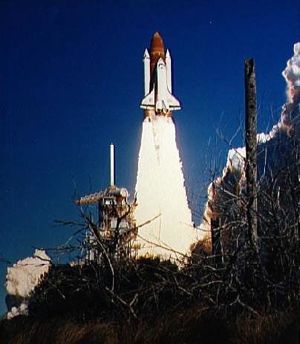 | STS-51-L Lift-off of the Shuttle Challenger for STS 51-L mission Credit: NASA |
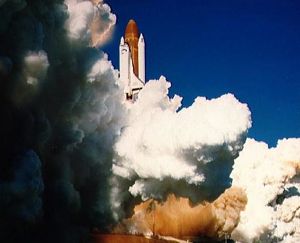 | STS-51-L Lift-off of the Shuttle Challenger for STS 51-L mission Credit: NASA |
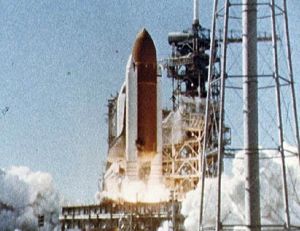 | STS-51-L Signs of black smoke during Lift-off of the Shuttle Challenger STS 51-L Credit: NASA |
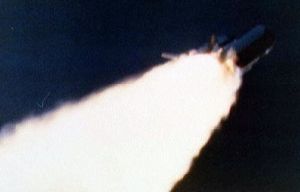 | STS-51-L View of the SRB problems with Challenger after launch Credit: NASA |
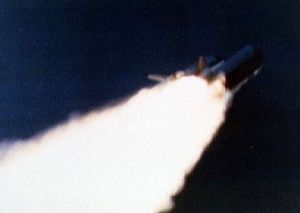 | STS-51-L View of the SRB problems with Challenger after launch Credit: NASA |
 | STS-51-L Challenger SRB destruction after launch Credit: NASA |
 | STS-51-L View of the SRB problems with Challenger after launch Credit: NASA |
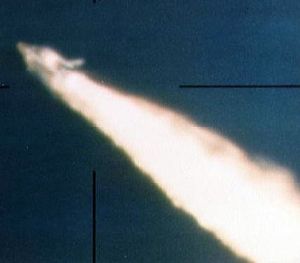 | STS-51-L View of the SRB problems with Challenger after launch Credit: NASA |
 | STS-51-L View of the SRB problems with Challenger after launch Credit: NASA |
 | STS-51-L Challenger accident after launch Credit: NASA |
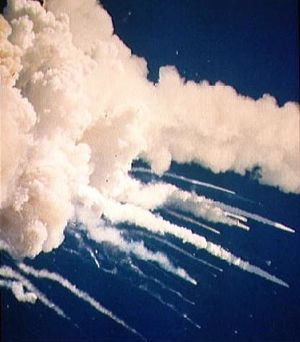 | STS-51-L Challenger accident after launch Credit: NASA |
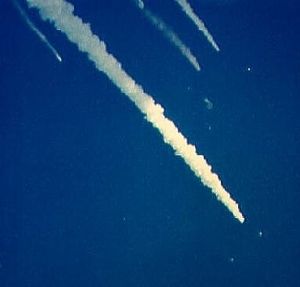 | STS-51-L Challenger accident after launch Credit: NASA |
 | STS-51-L Challenger accident after launch Credit: NASA |
 | STS-51-L View of ice on the launch complex Credit: NASA |
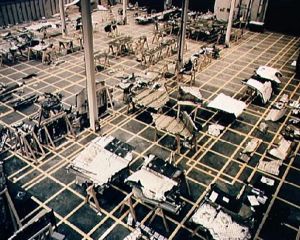 | STS-51-L View of debris in the Lockheed Log building Credit: NASA |
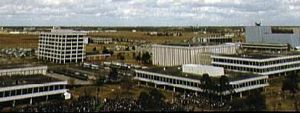 | STS-51-L The "missing man" formation concluded the memorial for the STS 51-L crew Credit: NASA |
1986 January 28 - . 16:38 GMT - . Launch Site: Cape Canaveral. Launch Complex: Cape Canaveral LC39B. Launch Platform: MLP2. LV Family: Shuttle. Launch Vehicle: Space Shuttle. FAILURE: Seal on SRB failed, allowed hot gas to burn through External Tank.. Failed Stage: 0.
- STS-51-L - . Call Sign: Challenger. Crew: Jarvis, McAuliffe, McNair, Onizuka, Resnik, Scobee, Smith. Payload: Challenger F10 / TDRS 2 [IUS]. Mass: 116,670 kg (257,210 lb). Nation: USA. Related Persons: Jarvis, McAuliffe, McNair, Onizuka, Resnik, Scobee, Smith. Agency: NASA. Program: STS. Class: Manned. Type: Manned spaceplane. Flight: STS-51-L. Spacecraft Bus: Shuttle. Spacecraft: Challenger. Duration: 0.0008 days. Decay Date: 1986-01-28 . Apogee: 15 km (9 mi). Exploded 73 seconds after launch, all 7 crewmembers were killed; carried TDRSS satellite..
Back to top of page
Home - Search - Browse - Alphabetic Index: 0- 1- 2- 3- 4- 5- 6- 7- 8- 9
A- B- C- D- E- F- G- H- I- J- K- L- M- N- O- P- Q- R- S- T- U- V- W- X- Y- Z
© 1997-2019 Mark Wade - Contact
© / Conditions for Use